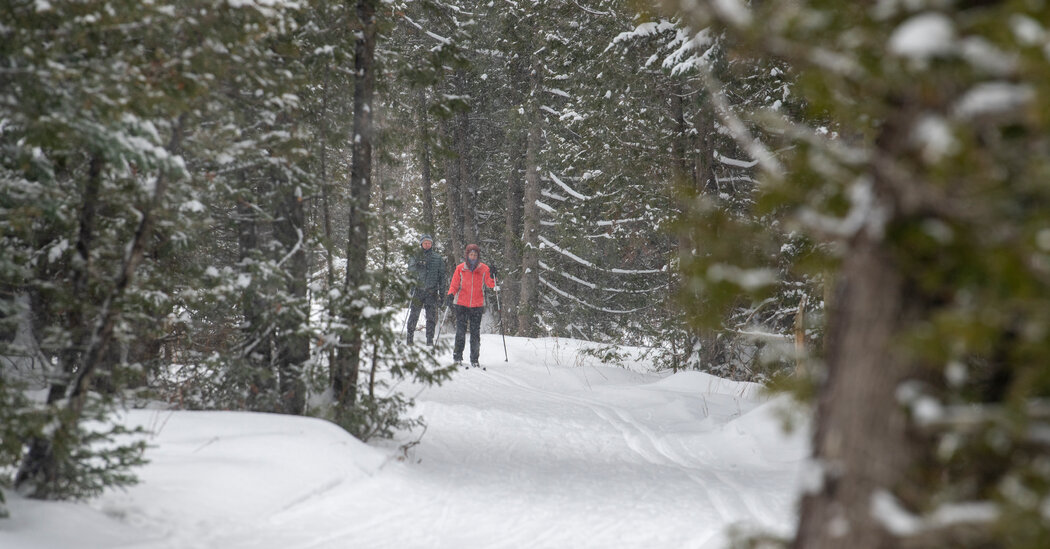
Skiing Town to Town in a Magical Corner of Vermont
03/07/2023It was a chilly February morning, and my friends were impatiently stamping their skis like horses eager to leave the barn. We had miles of snowy trails to ski and I had been dawdling too long over my gear. We made final adjustments to our equipment, and I inhaled an energy bar inside a self-service ski cabin at Highland Lodge, a century-old inn in Greensboro, Vt.
Five of us stepped into our lightweight cross-country skis for the 12-mile, town-to-town journey on groomed ski trails through a postcard-pretty landscape. It would take us about four hours to ski to our destination, the Craftsbury Outdoor Center, in the heart of Vermont’s wild Northeast Kingdom. We planned to stay overnight, dine there and spend the next day exploring its 105-kilometer, or about 65-mile, network of ski trails and other offerings. I wanted to see up close why Craftsbury has quietly become one of the country’s premier cross-country skiing centers, an innovator on sustainability and a pipeline for Olympic aspirants.
Minutes after leaving Highland Lodge, I paused at the top of a meadow and looked back at the frozen expanse of Caspian Lake below. My companions skied toward me, arms and legs moving in the rhythmic kick and glide of Nordic skiing. Wind-whipped snowflakes stung my cheeks. I turned and skied briskly to reach the shelter of the forest ahead.
I was gradually climbing up through snow-plastered trees when I encountered several other skiers. Among them was John Brodhead, 79, the former director of skiing at Craftsbury Outdoor Center. He and I first met on this trail back in the 1990s when Mr. Brodhead ran the Craftsbury Marathon, which attracts top ski racers. I showed up because of the food. For a number of years, the marathon included both a racing and touring division and featured refueling stops with delectable fare provided by local innkeepers and restaurateurs. I skied from curry soup to blueberry tarts, happily enjoying civilized comfort through an untamed stretch of Vermont.
The Craftsbury Marathon continues to draw more than 500 racers every year. As for me, when the food stopped (“It was a logistical nightmare,” Mr. Brodhead told me), so did I.
As we stood beneath the snowy mantle of maple and birch trees, I asked Mr. Brodhead, who was instrumental in developing the town-to-town Highland Lodge ski trail, about the origin of this unusual tour.
“The inspiration for this trail comes from Europe, where I saw point-to-point races and how much skiers and tourists enjoyed that,” he said, leaning on his poles and catching his breath before the next uphill.
The goal, he said, “was the adventure.”
‘It’s just great to be outside.’
Cross-country skiing is enjoying a revival. About five million people participated in the sport in the 2021-22 winter — roughly double the number of a decade ago. Retail sales of Nordic ski gear jumped 158 percent last winter, according to Nick Sargent, the president of Snowsports Industries America. He attributes the spike in interest partly to Covid, but also largely to “how healthy the sport is,” he said. “There is no traffic, no lines and you can participate for one to two hours, and it’s just great to be outside.”
My ski partners and I soon crested a hill. I followed my friend Todd Eastman on a fast descent, trying to match his graceful telemark turns down a freshly groomed forest trail that had a velvety corduroy texture. Todd is a veteran Nordic skier so I trusted that I could ride close on his tails. Suddenly, he lost his balance and was on the ground looking up at me, grinning widely. I careened left into the powder to avoid skewering him.
The trail burst out of the forest into a broad meadow. The soft summits of the Northeast Kingdom framed the scene. The sun broke through and reflected off the new snow on a nearby peak, evoking the image of a freshly painted New England church steeple against a robin’s egg blue sky.
We stopped in front of a weather-beaten maple-sugaring shack to refuel on sandwiches and fruit that we carried in our backpacks. We admired the stately maple grove that would soon flow with sap for syrup.
The trail was bathed in gold light as we continued skiing into the afternoon, passing through the small village of Craftsbury and its general store. The big vistas gradually gave way to a sunny cruise alongside a babbling brook.
The closer we got to our destination, the more activity there was on the trails. At last, we crested a final hill and emerged to find a vibrant scene at the Craftsbury Outdoor Center. Skiers were heading out in all directions. Children squealed in delight as they skied after one another and darted around plastic cones.
At the center of the activity was the touring center, a modern wood building capped with solar panels. My partners and I leaned our skis on the deck and went inside. People sat at long tables and peered out through the large glass windows onto the bustling, sun-soaked field that resembled a cross-country Grand Central. Between 2011 and 2019, the number of skiers visiting Craftsbury tripled. While my friends relaxed and took in the scene, I talked to the couple who remade this rural outpost into a skiing mecca.
Where the coaches are Olympians
The town of Craftsbury, population 1,343 (2020), is in a rural region known for logging, farming, maple syrup and lately, Olympic athletes.
In 2008, a new era dawned when the 35-year-old Craftsbury Outdoor Center was purchased by Judy Geer, 69, and Dick Dreissigacker, 75, Olympic rowers who lived and worked in nearby Morrisville. Mr. Dreissigacker is a co-founder of Concept 2, which makes high-tech oars and indoor rowing machines that are found in fitness centers and homes around the world. When the couple bought the outdoor center, they turned it into a nonprofit foundation with a three-part mission to promote sports, sustainability and stewardship.
“They’re creating their dream,” said Reese Brown, the director of the Cross Country Ski Areas Association.
Community is the lifeblood of the Outdoor Center. About three-fourths of its ski trails are on private land. Most of the roughly 100 landowners agree to host the trails based on a verbal agreement with Dick and Judy, as they are universally known around town — and “fresh baked cookies,” Ms. Geer added with a smile.
Vermont schoolchildren and residents of the three neighboring towns ski free at Craftsbury, and a season pass costs just $50. Elite post-collegiate athletes in cross-country skiing, biathlon (which combines cross-country skiing with rifle marksmanship), running and rowing train at no charge as part of Craftsbury’s Green Racing Project. They dream of competing in the Olympics, but they also coach children in the local ski club and schools and help keep the campus running. Six members of the G.R.P. competed in the 2018 Winter Olympics in Pyeongchang, South Korea.
“The model here of embracing balance and finding value that’s derived from something other than just your sport — that’s derived from how you contribute to your community — is what made the sport sustainable for me,” said Susan Dunklee, 37, a G.R.P. member, three-time Olympian and the most decorated competitor in the history of American biathlon. She is now the director of running for G.R.P.
In 2014, Mr. Dreissigacker and Ms. Geer transformed the humble campus by constructing an airy, ultra energy-efficient touring center and gym. Modern cabins replaced an old ski dorm a few years later, and the communal dining hall was expanded; it now features local food, including produce grown in gardens tended by the athletes. The campus gets its heat and hot water from a central heating system powered by wood, solar energy and waste heat from snow-making. Most of the electricity comes from large solar panels that are visible on roofs and around the ski trails.
Craftsbury’s sustainability focus is driven both by idealism and practical concerns. New England experienced its warmest January on record this year, leaving many cross-country ski areas unable to open. But Craftsbury opened before Thanksgiving thanks to its innovative snow storage system. Each winter, the center uses snow-making equipment to create a mound of snow, which it then buries beneath 18 inches of wood chips. It is stored through the summer, then used on the trails the following winter. Mr. Dreissigacker explained that he had seen this method of snow storage used successfully in Scandinavia. In Craftsbury, it has been a success: About 60 percent of the snow survives the summer heat, and the stockpile enables Craftsbury to open for skiing in November.
Ms. Geer, who can be seen in her oversize down jacket directing volunteers at the countless races and festivals at the center, said that her greatest reward is seeing the magic that happens on the snow in Craftsbury.
“I love the interaction between all the groups,” she said. “We have normal people in camps, we have Olympic development athletes, and I especially like that little kids get to be coached by Olympians. And we have a lot of women coaches. That’s really good for all the kids here.”
Hitting the target
That night, my ski partners and I stayed in a comfortable Scandinavian-style cabin with an open floor plan (lodging ranges from $190 to $410 per double, including meals, ski passes and use of the fitness center) that overlooks Great Hosmer Pond, the site of Craftsbury’s rowing program. For dinner, we walked to the dining hall, which was filled with guests eating family-style at round tables. It had the feel of an adult summer camp. But instead of traditional camp fare, I was treated to a delicious locally sourced meal of vegetable lasagna, kale salad with maple chipotle dressing, and a maple blondie parfait.
With all the current and aspiring Olympians around Craftsbury, I was determined to avail myself of some of their wisdom. So, the next morning, I sought out Ms. Dunklee, who agreed to give me a few pointers on the biathlon shooting range in front of the touring center.
Ms. Dunklee lay prone in the snow and showed me how to hold the rifle and line up the target as I peered through a tiny gunsight. I was aiming for a baseball-size black dot 50 meters in front of me.
“Breathe in. Exhale. Squeeze,” she intoned calmly, sounding more like a meditation master than a world-beating competitor.
Clank. Clank. Thunk.
“You hit the target!” she declared.
It was my Olympic moment. And no one was more surprised by it than I was.
David Goodman is the author of “Best Backcountry Skiing in the Northeast” (AMC Books) and host of “The Vermont Conversation,” a public affairs podcast and radio program. Follow him on Twitter: @davidgoodmanvt.
Follow New York Times Travel on Instagram, Twitter and Facebook. And sign up for our weekly Travel Dispatch newsletter to receive expert tips on traveling smarter and inspiration for your next vacation. Dreaming up a future getaway or just armchair traveling? Check out our 52 Places to Go in 2023.
Source: Read Full Article

